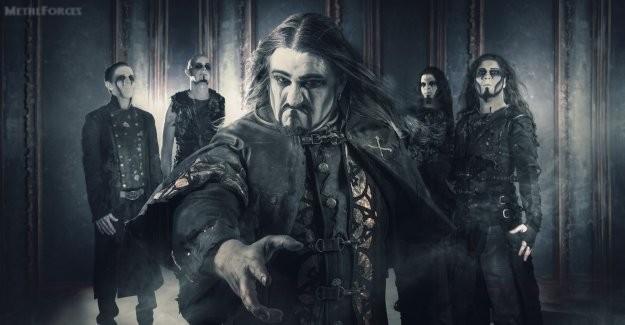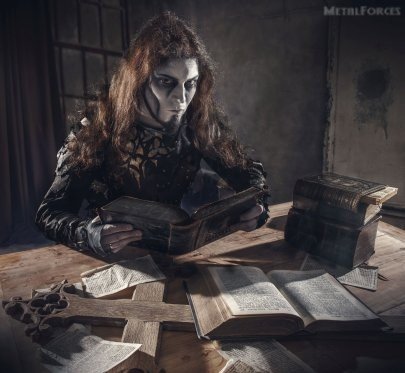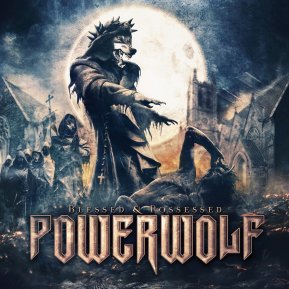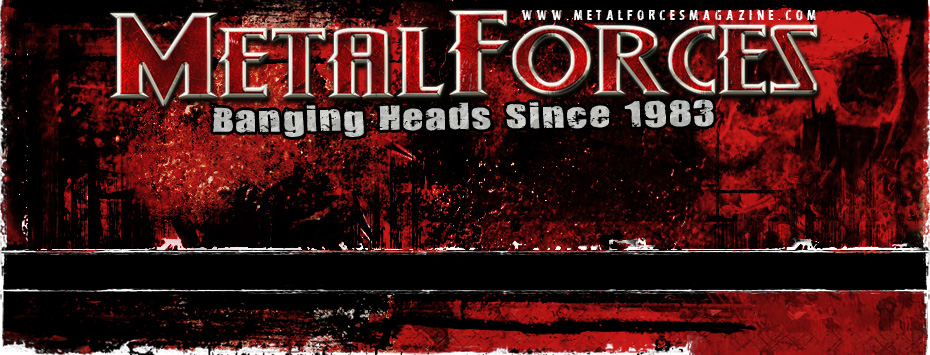
POWERWOLF – Armed In The Night
Anthony Morgan
July 2015
 Powerwolf (l-r): Falk Maria Schlegel, Roel van Helden, Attila Dorn, Charles Greywolf and Matthew Greywolf |
![]()
The overall process of making July 2015 outing Blessed & Possessed – the sixth full-length studio affair from German metal group Powerwolf – took roughly nine months in all. Initially, writing tracks in support of the platter was “quite hard”, Powerwolf’s previous jaunt in July 2013’s Preachers Of The Night having arguably been the band’s most successful album up until that point.
“Preachers Of The Night was not only our most successful album but also an album which we still absolutely love, so it was quite hard to start coming up with new songs that would do justice to the legacy of this album,” Matthew Greywolf admits, guitarist and founder of Powerwolf. “It took quite a while until we had written the first song, but the first song we finished was the title track in fact – ‘Blessed & Possessed’. We realised that we could still do it; when this one was written, the rest of the songwriting started flowing.”
Authoring compositions, Powerwolf doesn’t adhere to an established formula. “No, not at all,” the composer affirms. “Creating art, creating music is something like a very intuitive process, so you could never plan this. We are a band that never takes conscious decisions or plans what to do. In fact, what we did for Blessed & Possessed was that in a lot of cases, the starting point for a song always was in fact a melody line, which means we write a lot of songs without actual instrumentation. We just sing vocal lines, and then start elaborating the song around that.”
Penning tunes in such a fashion ensures each respective track boasts a hook-laden chorus. “Yes, kind of,” Matthew responds. “It’s not really the purpose of why we do it. It’s not like there’s a rule that the song has to be catchy, but yes, you’re correct. Maybe it’s due to the way we start writing songs that the chorus in most cases is the central part of the song.”
Most rock and metal-oriented songwriters tend to devise a riff, and work from there. “I could never write a song based on a riff, or it wouldn’t become a song – it would become a row of riffs,” the axeman reasons. “The thing is, I’m quite convinced that you imitate yourself when writing a song on a guitar or something, because you start playing the typical chords you play when having a guitar in hand. When you create a melody by just singing into your cellphone or whatever, you don’t imitate yourself. You just sing what sounds good, and we’re sometimes even surprised when we start transcribing what we have sung and then start working it out on the guitar. It often ends up in stuff I would never have played when I just sit down at home with my guitar, so it’s kind of interesting and challenging writing this way.”
Although Matthew composes the initial idea for a given song in the majority of cases, that resultant idea is fleshed out as a band entity. “I’m convinced that if you want a song to become a song which has good dynamics and really becomes a great live song, you have to write it as a band because it demands the whole dynamics of the band, so we combine it,” he submits. “The basic ideas are elaborated by a single person, but then it takes the whole band to really make a song out of it.”
Having now written and issued a collection of tracks in the form of Blessed & Possessed, that aforementioned collection of tracks will inevitably be compared to past material. “It’s very hard, because I’m still very close to the project,” the lyricist ponders. “I don’t have a view on it, but I would say it’s more dynamic in fact. There are a lot of great live songs on this album, and I would say that we have developed the details even further. There is obviously not a very major difference between the albums, which is just due to the fact that we just love the style we play in.
“It wouldn’t be honest to consciously change it, but we have gone into details. For example, the classical choirs are much better integrated into the songwriting than in the past, which means they are not that obvious any more. They are more doing little details within the songs. It’s not like you have a heavy metal band and then you have a choir on top, but when you have heavy metal with a choir, there’s subtle things in it. I think we have developed our typical trademark style a step further.”
Blessed & Possessed’s lyrical content can be interpreted in multiple ways. “A good point to start with is the album title Blessed & Possessed, which displays the ambiguity between…,” Matthew begins. “Let’s say ‘blessed’ being a metaphor for a religious life or a life defined by a set of rules and morals, and ‘possessed’ as the opposite – like instinctive behaviour. We kind of used this concept on a lot of songs, like on ‘Sacramental Sister’ for example, which is a story about a nun being torn between a pile of lies and sexual desire. Then as well though, you can relate Blessed & Possessed to Powerwolf because it describes how we are as a band.

|
“If you see ‘blessed’ as the epic element – the classic element within the music – and ‘possessed’ as the heavy metal side, the wild side of the music, it’s a very good way to describe how Powerwolf are. Especially the ‘possessed’ kind of thing is a thought that’s very important for us, because we are possessed by what we do and heavy metal fans in general are possessed by heavy metal. It’s more than just listening to heavy metal; it’s living heavy metal, it’s being possessed by heavy metal. There are several levels of how this album title relates to the band and the topics on the album.”
Composition ‘Armata Strigoi’ bears a title which is Romanian in origin, its literal English translation being ‘undead army’. “‘Armata Strigoi’ is a song that we’re often asked about, because the title isn’t that self-explanatory,” the axe-slinger observes. “It relates to the Romanian or in general east European translations of the strigoi, which is a kind of undead creature, which the archetype of later on kind of became the vampire. It’s very interesting to research stuff like that. We are really obsessed with reading about old legends; for example, we read a lot about that creature strigoi, which is described very differently in a lot of translations. It’s kind of challenging to pick such topics and transform them into heavy metal lyrics.”
Number ‘Army Of The Night’ functions as Blessed & Possessed’s inaugural music video, meanwhile. “‘Army Of The Night’s is similar to the song title,” Matthew describes. “It’s something you could interpret as self-reference. Metal shows usually happen at night, and it describes the feeling of a heavy metal show. During the daytime, things are quiet. For example, on tour you wait for a show to start in the night. The process is that you go out together with the audience, and sometimes it really feels like a big army when the band and the fans are really giving a push to each other. It describes the feeling of a Powerwolf show, definitely.”
Whether further music videos will be filmed to promote Blessed & Possessed is uncertain. “To be honest, I’m not quite sure we will do another video,” the guitarist muses. “It’s not exactly what we like most. There are no plans for a second video clip right now, but maybe there will be some kind of live clip or something coming up. Playing live is what Powerwolf is all about, so we have not scheduled any further video shooting. We’ll see what the future brings. First of all, we have the festival season coming up. We have our first tour for Blessed & Possessed from September to November, so our schedule is quite busy with playing live right now.”
Familiar faces were involved in the recording process. “We worked with the same team as on the last album, which means we worked once again with Fredrik Nordström at Studio Fredman, and we have Jens Bogren who did the mastering of the album,” Matthew informs. “All I can tell you is that it is a very good team. We just worked together very efficiently, very creatively. That’s basically the reason why we did the album with the same team as from the past.
“We started in early January I think, and we were finished with the mix in March. It took us three months, and it’s been three very busy months. One month was spent doing nothing but classical voices, because we recorded them all separately. This time, it was 30-35 singers, and all of them came to the studio separately. It was quite a busy schedule, as you can imagine.”
As has been the case with past efforts, keyboardist Falk Maria Schlegel recorded his organ parts at a small church in Thionville, France. “It isn’t that far away from where we live in Germany,” the songwriter shares. “It’s a great event every time we go there, because it just sounds great if you sit in an empty church, and the great church organ is playing the song. We really celebrate that all the time we’re there. It’s quite unique, but it’s something that makes the whole recording process very special for us. In the past, we have always used churches to record the classical choirs as well as the organ. It’s just a very special feeling, because in the end, recording studios are all the same. You just sit in this room with a big mixing desk, and no windows, and nothing. It’s just boring as hell. Recording your music in a church is something really, really special.”
Production was kept in-house. “We never have a producer in the sense that there’s somebody involved in the making of the music, because that’s what we do ourselves,” Matthew explains. “Finally, it’s Fredrik Nordström who is taking over the mixing, but during the recordings it’s definitely self-produced.”
The axeman’s guitar work on Blessed & Possessed isn’t of the virtuoso ilk. “I’m not the kind of guitar player who needs some exposure for my playing abilities or something when writing songs,” he judges. “I don’t even consider myself a guitar player. When writing songs, I just feel like I’m a part of the whole thing. When it comes to working out guitars, I try to be as song efficient as possible. I don’t need a big solo spot or something in any song. This time, what was very important for me sound-wise was to get a lot of tone. Not distortion per se and not the fattest guitar sound ever, but a very decent tone on it – a tone within the distorted guitar. Something really traceable. I wanted a guitar that sounds musical. Not brutal, but musical.
“Sometimes you get productions where the guitars sound like razors. It’s just like cutting, but there’s not much of a tone in it. There’s no bottom to the guitars, no body. What we tried to achieve is to have guitars that are really heavy; not heavy in terms of starting to hurt your ears, but heavy in terms of the fact that it’s got a good body.”

|
Matthew handled cover artwork duties, once again. “To me, it’s a lot of artistic freedom to be able to also deliver a cover artwork,” he feels. “To me, writing songs is closely connected. Writing a song always invokes pictures in my mind, but at the same time I start elaborating on the album, I start elaborating on possible front cover artworks. The one you see is the picture I had in mind when we started writing the title track, ‘Blessed & Possessed’. During the songwriting, more and more elements of the album cover came to life. That’s the process that goes on.”
The wolf emblazoned on Blessed & Possessed’s cover is a recurrent feature within Powerwolf artworks, suggesting the wolf is a mascot of sorts. “I wouldn’t go as far as calling it a mascot, but it’s obvious that all of our album artworks deal with a wolf in a way, and it’s obviously closely connected to the band’s name,” the wordsmith offers. “I wouldn’t call it a mascot, but to me, it’s essential to have something related to wolves, definitely.”
Given each respective artwork is designed by Matthew himself, this lends Powerwolf’s imagery a distinctiveness to an extent, a distinctiveness not enjoyed by many groups. “Definitely,” he agrees. “It’s a very good way to do exactly what we have in mind, and not compromise with anybody.”
A limited edition version of Blessed & Possessed includes a bonus disc, the disc in question boasting ten cover renditions. “It’s not just a bonus disc,” the axe-slinger views. “It’s a completely second album. There’s actually two digipaks released within a box, and the album is called Metallium Nostrum. We have put ten cover versions on that album, which are cover versions of songs that are influential to us. The idea was not to cover ten big heavy metal hits, but to cover songs that are personally important for us. It was a lot of fun doing this project, definitely. We recorded them after the record. It was actually after we had finished the mix for Blessed & Possessed, we realised that we should realise this idea. We had the idea for this covers album in mind for several years, but it never worked. This time it was like we do it now or never, so you could say that right when we came back from Sweden – where we mixed Blessed & Possessed – we just jumped into the studio to record Metallium Nostrum.”
Most bands tend to issue cover platters as lone affairs. “We didn’t think about it, because in fact the idea was that it would be a bonus album,” Matthew notes. The reason why we did such extensive production for a bonus album was that we are still fans, definitely. As a fan, I’m always really pissed when I buy a limited edition of something, and the bonus disc contains two songs in demo versions or something like that. Nobody needs that, so we wanted to deliver something worth it, and definitely value for money. That’s why we did this project.”
Blessed & Possessed was released on July 17th, 2015 via Napalm Records.
Interview published in July 2015.
Related Posts via Categories
- SCOTTISH SICKNESS – A Report On The Scottish Death Metal Scene, Featuring BRAINBATH, PUTRID FATE And RANCID CADAVER (October 2022) | Features / Interviews @ Metal Forces
- LARVAE – Join The Hardcore Cult! (June 2022) | Features / Interviews @ Metal Forces Magazine
- TRENCH FOOT – Sacrificing Morals For Gory Obscenities (June 2022) | Features / Interviews @ Metal Forces Magazine
- L.A. GUNS – Trigger Happy (March 2019) | Features / Interviews @ Metal Forces Magazine
- CANCER – Crimes So Evil (November 2018) | Features / Interviews @ Metal Forces Magazine
- U.D.O. – The Tank Drives On (August 2018) | Features / Interviews @ Metal Forces Magazine
- SIEGE OF POWER – Bleeding For The Cause (August 2018) | Features / Interviews @ Metal Forces Magazine
- MOONSPELL – A Taste Of Live Eternity (August 2018) | Features / Interviews @ Metal Forces Magazine
- MONSTROSITY – Dark Matter Invocation (August 2018) | Features / Interviews @ Metal Forces Magazine
- SATAN – Five Magicians (August 2018) | Features / Interviews @ Metal Forces Magazine
|
|





